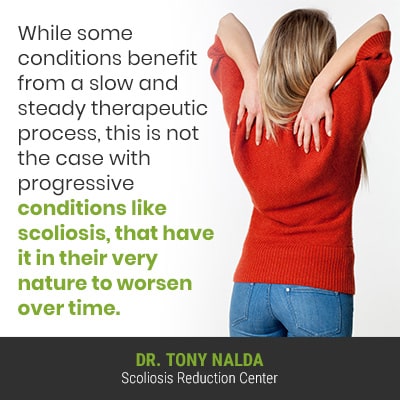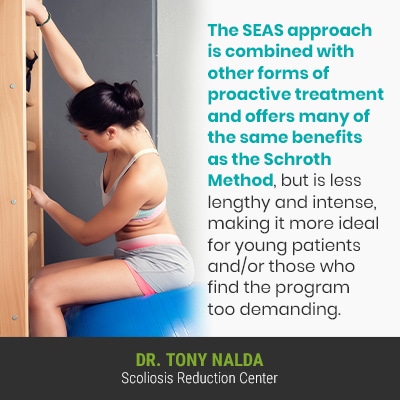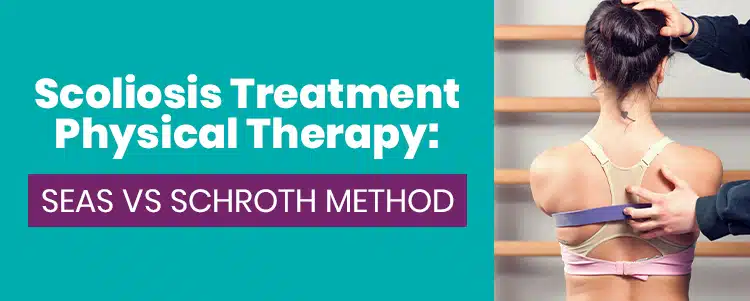Scoliosis is a complex condition that necessitates the customization of effective treatment plans. By integrating multiple condition-specific treatment disciplines, the condition can be impacted on every level. Exercise and physical therapy can help with increasing spinal support/stabilization through increasing core strength and addressing sore, strained, and unbalanced muscles.
With physical therapy, we’re talking about one facet of a conservative scoliosis treatment approach. Physical therapy approaches, such as SEAS and the Schroth Method, can help with increasing core strength, postural remodeling, natural body positioning, and improved brain-body communication.
Before getting to the specifics of SEAS vs the Schroth Method, let’s first discuss the general role of physical therapy in scoliosis treatment.
Physical Therapy in Scoliosis Treatment
While the role of exercise in scoliosis treatment was once questioned, we now understand that when it comes to treatment efficacy, there is a big difference between general exercise and physical therapy, and scoliosis-specific exercise and physical therapy.
As such a complex condition, scoliosis treatment is beyond the scope of general medicine, requiring a scoliosis specialist to treat the condition effectively.
Standard physical therapy combines stretches, massage, and strength training designed to remove movement restrictions and increase mobility.
Just as a sports-related knee injury will require specific exercises, so too does scoliosis; when it comes to scoliosis, physical-therapy programs will be specific to each patient and their condition, which is why a general physical therapy program will fall short when it comes to impacting scoliosis.
In addition, certain exercises, stretches, and activities are known to interfere with treatment, exacerbate symptoms, and can do more harm than good, which is why no form of exercise or physical-therapy program should be attempted without first being cleared by the scoliosis-treatment provider.
As I mentioned that scoliosis physical therapy has to be condition-specific, let’s address some of the general ways that scoliosis physical therapy would differ from general physical therapy.
Scoliosis-Specific Physical Therapy is More Intensive
For physical therapy to be effective as a facet of scoliosis treatment, it needs to be delivered at a more intense rate and for a shorter duration.

While some conditions benefit from a slow and steady therapeutic process, this is not the case with progressive conditions like scoliosis, that have it in their very nature to worsen over time.
By condensing the time frame and physical therapy intensity, it’s possible to counteract the condition’s progressive nature, particularly when combined with other proactive treatment disciplines with corrective potential.
Working proactively to counteract the condition’s progressive nature means potentially preventing progression, escalating symptoms, and the need for more invasive surgical treatment in the future.
I want to be clear, however, that although scoliosis physical therapy is more intense than general therapy might be, it’s not more painful, as part of customizing treatment plans involves designing exercise programs around patient age, ability, and condition severity.
Condition Severity Helps Shape Physical Therapy Programs
As mentioned, scoliosis treatment plans have to be customized to address key patient/condition characteristics, and severity is an important variable as scoliosis can range from mild to moderate and severe to very severe.
Condition severity is determined by a measurement known as Cobb angle, and the higher the Cobb angle, the more out of alignment a scoliotic spine is, and the more likely it is to cause noticeable symptoms:
Mild scoliosis: Cobb angle measurement of between 10 and 25 degrees
Moderate scoliosis: Cobb angle measurement of between 25 and 40 degrees
Severe scoliosis: Cobb angle measurement of 40+ degrees
Very-severe scoliosis: Cobb angle measurement of 80+ degrees
Naturally, the type of therapy recommended for someone with mild scoliosis is not going to be the same as what’s necessary in severe cases, just as general physical therapy demands are not going to be the same as scoliosis physical therapy demands.
Regardless of age or severity, physical therapy has a place in scoliosis treatment.
Scoliosis Physical Therapy can Work for Patients of Any Age
While scoliosis is the most prevalent in children and adolescents, it can affect infants to the elderly, and every age in between.
The type and intensity of physical therapy exercises will differ from patient to patient, and patient age is factored into the crafting of effective treatment plans.
Physical therapy can be helpful as a facet of scoliosis treatment at any age as it’s not just the spine that’s in charge of maintaining its natural curves and alignment, but also its surrounding muscles, which can always benefit from being strengthened through exercise.
Physical Therapy Needs to be Part of a Larger Treatment Plan
As such a complex condition, ranging widely in severity, and having different condition types, no one treatment discipline, no matter how effective, will be enough to impact scoliosis on every level.
When combined with other forms of corrective treatment such as condition-specific chiropractic care, corrective bracing, a home-rehabilitation program for further stabilizing the spine for long-term sustainable results, physical therapy can help by increasing core strength.
As the spine’s surrounding muscles have to provide it with support so it can maintain its healthy curves/alignment, any type of therapy that increases core strength can help scoliosis by providing the spine with optimal support and stabilization, but as a structural condition, scoliosis has to, first and foremost, be impacted on a structural level, which is why no physical therapy program on its own can correct a scoliosis.
However, when combined with other distinct treatment modalities, patients can experience a curvature reduction on a structural level, increased core strength for optimal support, and make improvements to spinal mobility and function.
Now that we’ve addressed some general aspects of physical therapy for scoliosis, let’s now address two specific scoliosis physical therapy programs: SEAS vs the Schroth Method, and highlight the differences.
What is SEAS?
SEAS stands for Scientific Exercises Approach to Scoliosis, and is a type of physical therapy that focuses on the corrective potential of scoliosis-specific exercises (SSEs).
SEAS employs the use of self-correction techniques performed without the use of equipment, and these techniques are customized to suit each patient’s condition type.
The main goal of SEAS is to make the spine more stable by using scoliosis-specific exercises to trigger neuromotor function to be stimulated by reflexes, postural remodeling, and a more natural body positioning.
SEAS can be performed on an outpatient basis two or three times weekly, for approximately 45 minutes/session, and it can also be easily performed at home for approximately 20 minutes a day, coupled with an intense physiotherapy session of 1.5 hours every few months.
So a benefit of SEAS is the length of sessions, the duration of treatment, the lack of equipment needed, and a more flexible approach that tends to produce better compliance; it’s not as lengthy/intense, which is particularly helpful with adolescent patients, and this is why I favor its use over the Schroth Method.
Here at the Scoliosis Reduction Center®, I combine SEAS with other treatment disciplines for the best potential results.
What is the Schroth Method?
The Schroth Method for treating scoliosis is another physical therapy approach, similar to SEAS, but less lengthy; it also uses specific exercises that are customized to each individual patient to impact the condition on different levels.
The Method works towards restoring a more natural spinal position, and the end goal of Schroth exercises is to elongate, de-rotate, and stabilize the spine in all three dimensions; the rotational component of a scoliotic curve makes it a 3-dimensional condition.
Schroth’s physical therapy approach focuses on restoring spinal alignment and muscle imbalance and involves teaching patients to breathe into the concave side of their body, known as rotational angular breathing.
The Method also uses postural awareness, through the use of mirrors, to help reposition the spine.
The issue with the Schroth Method is that it’s a long-term approach to treatment that requires a full-time commitment to perform the specific exercises daily, and if not performed exactly as prescribed, they will be ineffective.
The exact intensity/length of treatment programs will be case-specific, as they have to address key patient/condition variables that change from patient to patient, but tend to run for 45 minutes to an hour, every day, for up to five months: sometimes longer, sometimes shorter.
In the condition’s most-prevalent form, adolescent idiopathic scoliosis, it’s particularly challenging to get these young patients to commit to such an intense/lengthy course of treatment, despite its potential benefits.

The SEAS approach is combined with other forms of proactive treatment and offers many of the same benefits as the Schroth Method, but is less lengthy and intense, making it more ideal for young patients and/or those who find the program too demanding.
Conclusion
The Schroth Method for scoliosis is a physical therapy program that uses customized condition-specific exercises to restore muscle imbalance, practice rotational angular breathing, and teaches postural awareness to encourage correction.
While the Schroth Method can produce successful results, it’s an intense and lengthy process that involves home exercises that have to be performed precisely as prescribed, and this can make compliance an issue that limits its potential efficacy.
Part of the reason behind the lengthiness of the Schroth Method is that it relies on physical therapy as the sole form of treatment to correct a scoliosis, but SEAS is one facet of treatment integrated into a plan that combines multiple condition-specific treatment disciplines that complement one another.
When combined with chiropractic care, corrective bracing, and a home-rehabilitation program, scoliosis can be impacted on every level: structurally, increasing core strength so the spine is optimally supported, and further stabilizing the spine through rehabilitation.
The complex nature of scoliosis necessitates a customized treatment approach; this is more aligned with an integrative approach that can apportion treatment disciplines accordingly based on how the spine is responding to treatment, which is why SEAS works so well as a facet of conservative treatment.




